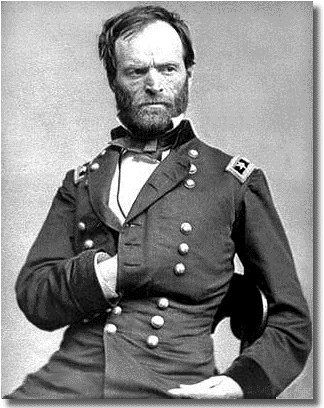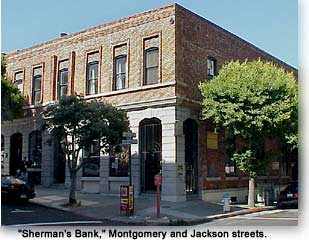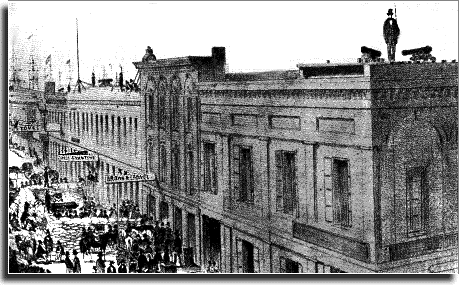William Tecumseh Sherman (1820 - 1891)
 One of America’s greatest army officers was born February 8, 1820
at Lancaster, Ohio, and graduated from the U.S. Military Academy in 1840.
One of America’s greatest army officers was born February 8, 1820
at Lancaster, Ohio, and graduated from the U.S. Military Academy in 1840.
Army lieutenants Edward Otho Cresap Ord and William T. Sherman
arrived at Monterey January 28, 1847, two days before Yerba Buena was renamed
San Francisco.
He accompanied the military governor of California, Col. Richard Barnes
Mason, during his July 1848 tour
of the gold fields to gather information for a report to the U.S. Government
and President Polk.
First regular steamship service to California was inaugurated by the arrival,
February 28, 1849, of the Pacific Mail’s steamer “California.” Gen.
Persifer F. Smith, new commander of the military division of California, was aboard.
Thomas O. Larkin and Capt. Sherman went into
the bay by small boat to greet the vessel, and Gen. Smith.
He left California and served as an officer in the commissary department
of the army, and resigned September 6, 1853 to return to California and take up
banking for Lucas, Turner & Co. He oversaw the construction of the new bank building
which opened July 11, 1854, at 800 Montgomery St. The building has survived earthquakes
and fires, and is know known as “Sherman’s bank” at Montgomery and
Jackson streets.
As a matter of coincidence, Capt. Ulysses
Grant resigned his commission in the army, July 31, 1854, at Fort Humboldt,
north of San Francisco, because his commanding officer said his weakness for liquor
was cause for court martial or resignation. Capt. Grant then came to San Francisco
and lived at the What Cheer House, a temperance hotel, just six blocks from Sherman’s
bank.
 Sherman was appointed by Governor J. Neely Johnson as major-general
commanding the San Francisco division of the California Militia on May 18, 1856,
when 3000 armed members of the Committee of Vigilance
marched on the county jail, removed Charles Cora and James Casey and placed them
under guard in the committee’s rooms on Sacramento St. Twelve days later Johnson
wired Gen. Sherman to meet him in Benicia. The governor said he might have to call
up the militia to restore law and order in San Francisco. On June 2, 1856, the governor
ordered Gen. Sherman to call up San Francisco members of the California Militia,
and on June 3rd the governor declared San Francisco to be in a state of insurrection.
Sherman was appointed by Governor J. Neely Johnson as major-general
commanding the San Francisco division of the California Militia on May 18, 1856,
when 3000 armed members of the Committee of Vigilance
marched on the county jail, removed Charles Cora and James Casey and placed them
under guard in the committee’s rooms on Sacramento St. Twelve days later Johnson
wired Gen. Sherman to meet him in Benicia. The governor said he might have to call
up the militia to restore law and order in San Francisco. On June 2, 1856, the governor
ordered Gen. Sherman to call up San Francisco members of the California Militia,
and on June 3rd the governor declared San Francisco to be in a state of insurrection.
Governor Johnson’s attempt to stop the Committee of Vigilance was
cut short when he asked Gen. John E. Wool, commandant of the army at Benecia, for
arms to help put down the San Francisco rebellion. The general refused. Sherman
resigned his commission in the militia after the meeting with Gen. Wool.
The Committee of Vigilance headquarters were fortified with sandbags to
stop any attacks by state militia ordered to quell the insurrection. Cannons are
mounted on the roof to forestall bombardment. On June 22, John Durkee of the Committee
of Vigilance led a raid on the schooner “Julia,” and hijacked the muskets
aboard, destined for the militia. He took the arms to the Committee’s headquarters
on Sacramento St.

The Committee of Vigilance dissolved soon after arresting California Supreme
Court Justice David Terry, and on September 6, 1856, a new Grand Jury sworn in by
the Court of Sessions. William T. Sherman was the foreman. He served on the Grand
Jury until May 5, 1857, when Sherman and his family left California aboard the “Sonora.”
Sherman, one of America’s greatest war heroes, returned to the U.S.
Army to fight the Civil War, and his service in the “War of Rebellion”
was memorialized by San Franciscans who named a street, and an elementary school,
on Union Street, in his honor.
For more information about Gen. Sherman, see:
The Museum’s Gen.
Sherman Bibliography
William T. Sherman –
California Before the Gold Rush — 1847
William T. Sherman
and the California Gold Rush
General Sherman and
the 1856 Committee of Vigilance
William T. Sherman’s
Papers at Notre Dame Archives
Return to top of page.
|